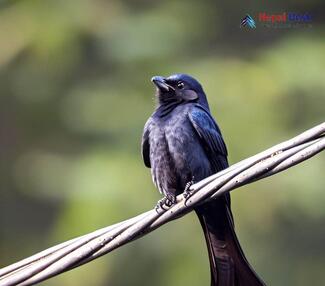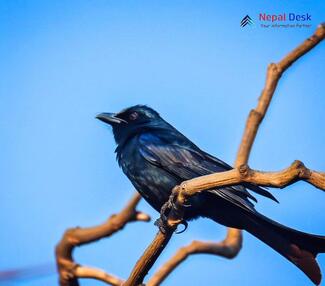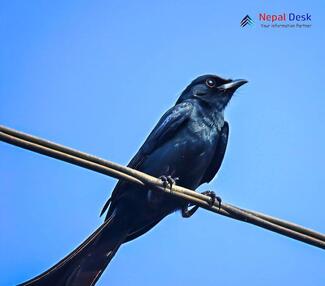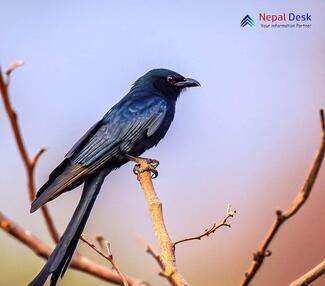The Black Drongo (Dicrurus macrocercus) is a small perching bird belonging to the drongo family Dicruridae. With its glossy black plumage, distinctive forked tail, and acrobatic aerial maneuvers, the Black Drongo is a common sight in Nepal's forests, grasslands, agricultural areas, and urban spaces.
An aggressive insectivorous bird, the Black Drongo plays an important ecological role in controlling crop-damaging insects and pests across multiple habitats in Nepal. Displaying great courage despite its small size, the feisty Black Drongo actively harasses much larger predatory birds like crows or birds of prey that threaten its nests. This fearless protective behavior has earned the diminutive Black Drongo significant cultural symbolism in Nepal as a guardian of other wildlife and even domestic animals.
As a highly adaptive species colonizing urban areas effectively, the Black Drongo serves as an important bioindicator of environmental trends across Nepal's changing foothills landscape. The rise and fall of its population reflects the health of Himalayan ecosystems and the impacts of climate change, habitat loss as well as urbanization pressures on native bird communities. Hence conserving the ubiquitous and recognizable Black Drongo is closely tied to preserving Nepal's overall avian biodiversity and ecological resilience.
With an embroidered history intertwining biological services, cultural beliefs, and environmental signals across Nepali societies, the boisterous Black Drongo warrants deeper focus as a bellwether informing regional conservation philosophies prioritizing avian biodiversity's contributions upholding local communities alongside ensuring healthy Himalayan ecosystems under global climate crisis.
Taxonomy and Classification
The Black Drongo belongs to the passerine family Dicruridae under the scientific name Dicrurus macrocercus. Passerines comprise the largest order of birds globally known as perching birds or songbirds.
Within the Dicruridae family, the genus Dicrurus consists of about 30 drongo species found mainly in tropical southern Asia and Africa. The Black Drongo classifies among 12 Dicrurus drongos native across the Indian subcontinent. Its closest evolutionary relatives include the Ashy Drongo and Crow-billed Drongo sharing physical features and behavioral traits.
Historically, the Black Drongo got its biological name Dicrurus macrocercus from Greek roots indicating its prominent forked tail shape. 18th-century ornithological records identified present-day Nepal as part of the native range of the vocal and conspicuous Black Drongo across the eastern Himalayas landscape.
Ongoing phylogenetic analysis continues examining evolutionary divergence among various drongo species inhabiting overlapping terrains in South Asia. But the Black Drongo remains distinguishable by its medium size, entirely sooty black plumage lacking any gray or white markings, slender build, and aerobatic flights riding air currents.
Physical Description and Identification
The Black Drongo is a medium-sized drongo measuring 19–24 cm in length with a weight of 24-30 grams on average. Both sexes exhibit similar glossy black plumage from head to belly without any distinctive markings. The stubby black bill has a hooked tip suited for an insectivorous diet.
The most discernible feature is the deeply forked tail ending in fine tapering streamers that appears elegant but disproportionately long relative to the Black Drongo’s body size. This flexible tail combined with slender, pointed wings allows extreme aerial agility. Legs and feet are black as well with sharp claws facilitating secure perching.
In Nepal, the nominate subspecies Dicrurus macrocercus macrocercus resides in foothills up to 1200m elevation. It can be identified by its smaller size and slightly more graduated tail with racket-shaped feathers compared to the northern race. First-year juveniles also show duller black feathers with faint scaling and a brown tinge becoming solid black after the first moult.
No notable sexual dimorphism occurs in Nepali Black Drongos though females may average marginally smaller in size overall. By observing the forked tail silhouettes and agile figure-eight flights alternating gliding and flapping, birders can easily recognize the Black Drongo across various districts year-round.
Genetic Makeup and DNA Analysis
Recent taxonomic studies analyzing the mitochondrial DNA and genomic evolution of Dicruridae drongos provide early insights into the genetic diversity across Dicrurus species. However, focused genetic research specifically on the Black Drongo remains limited.
Preliminary phylogenetic comparisons reveal a close evolutionary relationship between the Himalayan Black Drongo population relative to other Indian subcontinent and Southeast Asian subspecies. But deeper DNA analysis can further illuminate the genetic divergence between regional Black Drongo variants like the South Indian race Dicrurus macrocercus vima versus the Nepali nominate race D. m. macrocercus.
Ongoing biodiversity surveys are collecting Black Drongo DNA samples across multiple districts of Nepal to quantify localized genetic variation. These regional genome banks may uncover valuable population-level differences indicating local adaptation pressures on the morphology, behavior, and innate immunity of Nepali Black Drongos across the Terai, Mid-Hill, and High Mountain eco-climate zones.
Comparing genetic mutation rates can also inform estimates of historical patterns in isolation, inbreeding, or hybridization events during the evolutionary lineage splitting of ancestral Black Drongos colonizing the Indian subcontinent. Such insights guide appropriate conservation focus upholding genetic health against habitat loss now threatening narrow endemic Himalayan birds.
Overall, widening DNA profiling of Nepal's Black Drongo alongside museum taxonomic techniques promises to enrich predictive models steering science-based species preservation while adding another vivid brushstroke to the biological tapestry of the region.
Habitat and Distribution in Nepal
The Black Drongo occupies diverse habitats across Nepal including open woodlands, scrub jungles, cultivated fields, gardens, and human settlements from the lowland Terai below 300m elevation up to 1200m in the Middle Mountains.
In the higher foothills of the Churia Range, Black Drongos favor forest outskirts and riverine woodlands with adequate aerial perching sites interspersed among agricultural terraces that provide foraging opportunities. The birds adjust well to proximity to rural villages as long as some trees or shrubs provide nesting spots.
Towards central Mid-Hill valleys and the western Siwaliks, higher densities congregate in semi-urban areas alongside farmlands growing grains, orchards, and plantations that harbor winged insect prey populations. Here the adaptable Black Drongo even utilizes buildings, TV antennas, and cell towers as territorial watchpoints and nesting platforms.
The omnivorous diet and generalized habitat preferences of the Black Drongo facilitate its synanthropic affinity for human-altered environments across rural and urbanizing Nepal. However, habitat integrity remains important for sustaining native food supplies and nesting resources. So targeted conservation of remnant woodlots and old-growth trees amidst land use changes can nurture Black Drongo persistence.
Ecological Role in Nepal
Occupying an insectivorous trophic niche, the Black Drongo plays an important ecological function in controlling crop pests and regulating insect populations affecting forest health across Nepal. It thereby maintains a balance benefiting farmers and ecosystems.
The pugnacious Black Drongo also Fearlessly mobbs much larger birds like crows, kites, hawks, or even treepies that threaten its nests during the breeding season. Such distraction displays provide inadvertent protection allowing other small bird and mammal species to nest safely. This ecosystem service further endears it to local communities.
However, the adaptive Black Drongo also competes for prey and habitat resources with endemic species like flycatchers or fantails across mid-hill woodlands facing fragmentation pressures. Still, as opportunistic generalists, Black Drongos show greater resilience in adjusting to human encroachment relative to specialists.
Hence conservation research should assess the positive pest control and protective services the Black Drongo provides against concentrating aggressive behaviors that complicate the survival of other threatened avifauna across disturbed habitats. Integrating cultural, commercial, and biodiversity stakeholder incentives promises nuanced policies upholding multi-functional landscapes benefiting Nepali people and ecosystems alike through scientific farmscaping approaches prioritizing ecological balance.
Behavior and Life Cycle
The Black Drongo chiefly feeds on insects including grasshoppers, beetles, termites, caterpillars and bees often caught aerially or gleaned off foliage. Occasionally it eats berries or small vertebrates extending its versatile omnivore tendencies. Hunting frequently happens from favored exposed perches offering sweeping visibility to scan for prey movement.
The breeding season lasts from April to August in Nepal, aligned with monsoon rains optimizing food abundance. Nests comprise small cup-shaped structures built with twigs, roots, and stems placed mostly on tree forks high above the ground, though human structures also get adapted for nest sites near settlements. The typical clutch size is 4 or 5 eggs.
Both male and female Black Drongos incubate the eggs and care intensely for the altricial chicks. Fledglings appear by June sporting dull brownish plumage unlike adult black coats acquired via moulting after around 100 days total. Young birds then disperse seeking to carve out territories offering reliable insect sources and nesting spots which the species defends aggressively from intruders when breeding.
Migratory tendencies are limited for Nepali Black Drongos which maintain non-breeding home ranges year round. Altitude fluctuations of a few hundred meters do occur seasonally but large transboundary movements remain atypical. However Himalayan habitat changes necessitate tracking any shifts in historical movement patterns to assess carrying capacity alterations and climate impact projections across the regional landscape.
Cultural and Symbolic Importance
The fearless protective behavior of the Black Drongo harassing much larger predatory birds earned it reverence in Nepali folklore as a divine guardian. Locally the species even associates by name with the Hindu god Shani, worshipped for warding off threats to crops or livestock thereby benefiting rural societies.
Some indigenous Newar communities of Kathmandu Valley view Black Drongos as representations of deceased ancestors revisiting families in avian form. Their boisterous territorial antics, especially among courting couples, also provide a commonly referenced analogy for squabbling human relationships evoking humor across Nepali literature and oral traditions over time.
Such cultural stories spotlighting the feisty yet nurturing aspects of Black Drongo etiquette showcase a harmonious human-avian ecological mutuality historically through conceptual linking of social duties and environmental stewardship principles across Nepal's cosmologies. The prominent vocalizations and aerial Displays annually signify the renewal of these belief systems celebrating biodiversity and conservation as inseparable from human cultural identity.
So beyond a pest controller valuable for agriculture, the pugnacious Black Drongo holds deeper ties to Nepali heritage – both ecologically through balancing threatened ecosystems and symbolically immortalized in practices cementing social norms critical for community health. Hence grants conversing indigenous seek knowledge and biodiversity through a shared conservation ethos.
Conservation Status and Challenges
The Black Drongo remains currently listed as a species of Least Concern in the IUCN Red List owing to its large habitat range and healthy populations globally. However, specific status assessments within Nepal warrant deeper study as Himalayan ecosystems face mounting climate and land use pressures.
Major threats include habitat loss from rapid deforestation, urbanization, and agricultural intensification across Nepal's Mid-Hills and Churia ranges which compromise the preferred forest-farming mosaic habitats of Black Drongos. Drought risks, extreme weather events, and shifting pest ecology from climate change also raise conservation concerns on various fronts.
Encouragingly the buffer zones and corridors of protected areas like Chitwan National Park harbor good Black Drongo densities benefitting from moderated microclimates and insect bounties amidst preserved woodlands. Expanding such multifunctional landscapes lowers edge contrast while bolstering matrix habitats promises to reconcile conservation aims along with traditional community needs upholding cultural ties with the Black Drongo.
Integrating the species as a bioindicator guiding such social-ecological innovations and policy interventions advocates for its threatened ecosystem roles flagging deteriorating regional climates. Thereby while not immediately endangered, proactive stewardship of the Black Drongo spotlights wider ecological redemption further benefiting local cultures beyond just a single charismatic bird species for a healthy Nepali country.
Scientific Research and Studies in Nepal
Recent ecological surveys by Nepalese ornithologists have traced the distribution patterns and population densities of the Black Drongo across various habitats ranging from protected forests to human-modified environments. These establish baseline monitoring databases for long-term conservation.
Academics from Tribhuvan University, Kathmandu University, and the National Trust for Nature Conservation (NTNC) collaborate alongside international scientists to study the behavioral adaptations of Black Drongos to urbanization and climate change across Nepal's rapidly transforming landscapes. Findings inform predictive models guiding localized biodiversity policymaking benefiting the species.
Young Nepali researchers also make substantial contributions by banding Black Drongos for tracking movements, sampling genetic diversity, and quantifying pest control services conferring added ecosystem value. Such field investigations collect previously lacking ground-truth data at the critical India-Nepal transboundary while mentoring grassroots communities on participatory monitoring and upholding cultural connections with their resident wildlife.
Ultimately homegrown Nepali conservation science leadership investigating the Black Drongo's multifaceted roles - from bioindicators of habitat health to providers of commercial pest control services to focal points of heritage beliefs - fuels evidence-based solutions reconciling environmental policy goals and social justice priorities under economic change.
Birdwatching and Ecotourism
The ubiquity of the Black Drongo across Nepal's cultivated plains, village woodlands, and lower mountain slopes offers easy birdwatching access within proximity of popular tourist destinations like Chitwan National Park or Pokhara City.
Areas near Lumbini's sacred sites surrounded by wetland relics and farmlands provide prime habitat supporting dense Black Drongo congregation opportunities for both international and domestic visitors. Similarly, small community forests and wetlands dot Nepal's emerging outer Terai tourist circuit and host vocal aggregations warranting spotlighting as unique avian attractions.
Furthermore, coupling drongo nest observations with scientific demonstrations of the invaluable pest control services they provide local crops build public awareness underscoring the conservation value and cultural ties binding Nepali farmers with this species. Responsible ecotourism infrastructure investment informed by ecological sensitivity principles in turn sustains rural livelihoods and habitats.
Thereby the distinctive Black Drongo embodies scope for local community-centered models of nature tourism that balance biodiversity education with ethical rural enterprises – elevating a small bird into an ambassador for Nepali environmental heritage reflecting the greater Himalayan ecosystem.
Conclusion
The ubiquitous Black Drongo is interwoven into the very fabric of both Nepali ecosystems, as an adaptable bird bolstering indigenous food webs through insect regulation, and human social heritage as a prominent cultural symbol across farmlands and literature.
Yet monitoring its populations and conservation status remains imperative as continued habitat loss poses risks to the Black Drongo’s essential ecological services underpinning agricultural communities. Responsible landscape planning integrating patchwork woodlots and nesting avenues allows for reconciling urgent biodiversity aims.
Further scientific insights into the species’ urbanization adaptability, climate resilience, and genome diversity across Nepal's terrain gradient can inform policy innovations guiding sustainable development upholding these crucial biological partnerships with local cultures counting on the Black Drongo’s presence environmentally and spiritually.
Conserving the boisterous bird thereby showcases a paradigm where human prosperity meshes with wildlife health – be it ecosystem functioning or heritage belief systems – rather than isolated goals. This underscores why every Black Drongo patrolling Nepali country feeds more than itself but also our communities future.
Additional Resources
Further Reading
- Shakya, S. et al., "Breeding Ecology of Black Drongo in Chitwan National Park" Science Journal of Zoology. 2018.
- Pandey, S., "Adaptive Behavior of Black Drongos to Urbanization" Tribhuvan University Journal. 2021.
- Baral et al., "Phylogenetic Studies of Drongo Species in Nepal" Journal of Natural History Museum. 2017.
Nepalese Ornithology Societies
- Bird Conservation Nepal GPO Box 12465, Lazimpat, Kathmandu
Website: www.birdlifenepal.org - Ornithological Society of Nepal GPO Box 2411, Kathmandu.
Email: [email protected] - Bird Watching and Conservation Society of Nepal Email: [email protected]
Reach out to these societies for more information on membership, field trips, and research collaboration opportunities around Nepalese birds including the Black Drongo.




